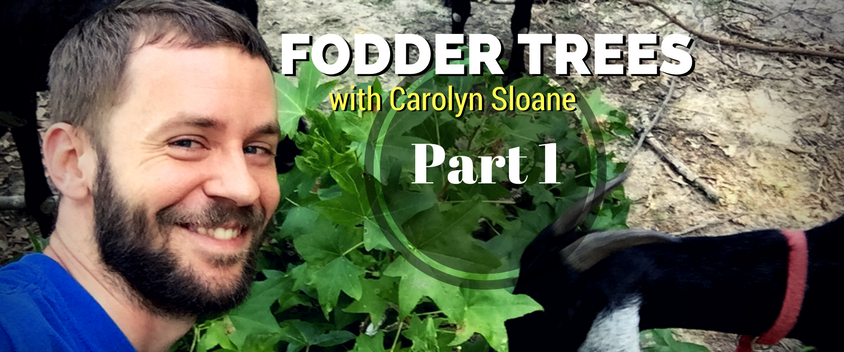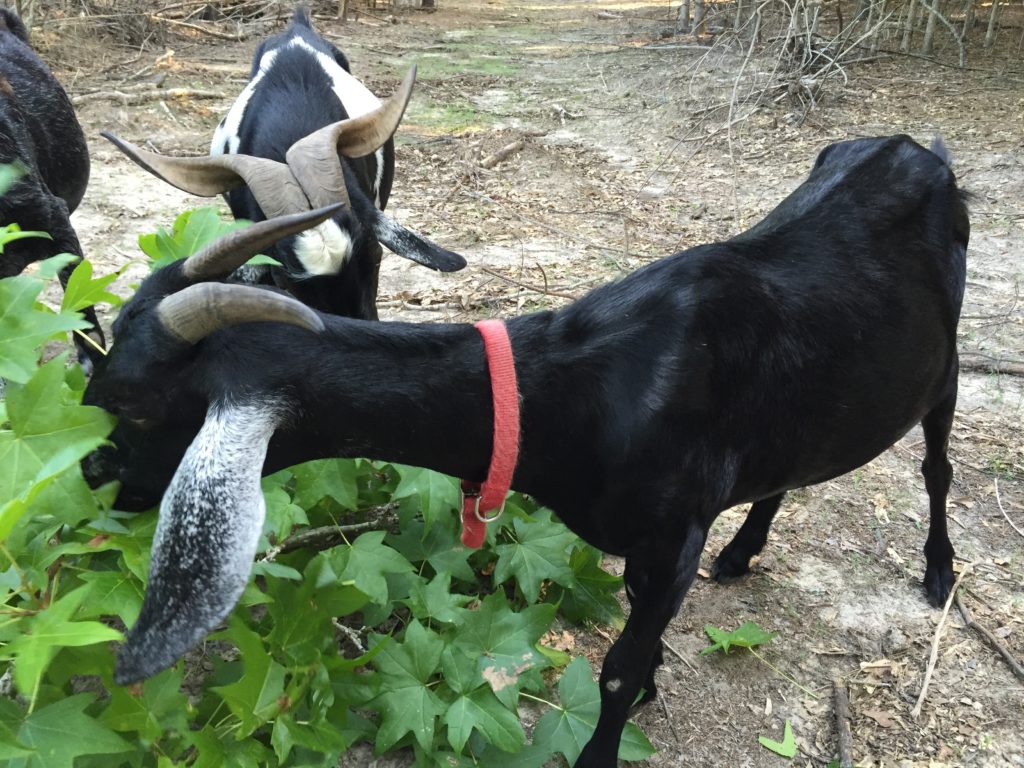E0031 | Fodder Trees: With Carolyn Sloane – Part 1
Podcast: Play in new window | Download
Subscribe: iTunes | Android | RSS
 This week, Ken was super busy with work, so I’m going to jump on this fodder trees topic that absolutely blew up on the Facebook group. Lots of people had questions and got excited about the prospect, so I thought it would be great to talk about that a bit and answer some questions. So I have a guest interview today! Carolyn Sloane is joining me via the marvel of modern technology to talk about tree fodder all the way from Vermont. It’s good to get a more northern climate viewpoint on this because in a future show you’ll get a lot of southern climate information from me and possibly another guest. But in this episode I try to make sure you get mostly her perspective and thoughts on how things work best in a colder climate. I’d love to see more people doing this and doing it well.
This week, Ken was super busy with work, so I’m going to jump on this fodder trees topic that absolutely blew up on the Facebook group. Lots of people had questions and got excited about the prospect, so I thought it would be great to talk about that a bit and answer some questions. So I have a guest interview today! Carolyn Sloane is joining me via the marvel of modern technology to talk about tree fodder all the way from Vermont. It’s good to get a more northern climate viewpoint on this because in a future show you’ll get a lot of southern climate information from me and possibly another guest. But in this episode I try to make sure you get mostly her perspective and thoughts on how things work best in a colder climate. I’d love to see more people doing this and doing it well.
We get a little over the top with what may be more advanced than some of you are comfortable with, but I try and always point out the ways even someone just learning about this can benefit from the knowledge and implement it right in your backyard while you’re listening to the podcast even. No expertise required, just a little effort! And you know me, that’s what I always try to point out, is that just about anybody can do something to bring themselves just a little bit closer to independence. Just some baby steps, or adding a little bit of knowledge might make you aware of an opportunity that others would miss. That’s what some people call “luck”. Just knowing what you can do can bring all sorts of “lucky” opportunities your way because you have your eyes open and have the knowledge to capitalize upon an unusual situation or opportunity. To get the meat of the episode, you’ll have to tune into the show!
[INTERVIEW WITH NICK & CAROLYN]
I had to cut the interview a little short here because we talked for an hour about this! So we’re going to have a second episode about tree fodder, and if you know me at all, you know I love this technique and the opportunities that these methods open up. This is in my opinion the backbone and whole structure of a profitable and resilient farm or homestead. It’s a larger scale endeavor for most people to implement and it takes time to build up to, but by all means we need to start sooner rather than later. I got set back a whole year in my development because I lost thousands of seedling trees this year. It’s life, sometimes you screw up, and learn from your mistakes. I learned that you don’t set up a nursery unless you can automate your irrigation needs no matter how much you think you’ll be able to water everything by hand. Sometimes you get sick and can’t hardly get out of bed for a week like what happened to me in June! Then you walk out to where your plants are supposed to be and a single section just didn’t get watered and there go your seedling trees. So start as soon as possible! I’m ordering more seed to stratify this winter, and if I can get a greenhouse set up, I’ll actually start the seed in pots in the greenhouse this winter to hopefully recover some of that lost time, so if you’re listening to this episode and decide you really want to get involved in this as well, then come join us on Facebook and ask your questions there where we’re having a great discussion!
In the second episode, we talk about appropriate technology and systems, the extra uses and benefits of implementing this kind of system on your property, how to harvest and use it, ways to stack functions with some tree crops, drying the harvest, storing it. We even get into some large scale implementation ideas and tactics that are probably beyond the scale and abilities of most homesteaders, but some of you might actually be able to benefit from the grander scale ideas we talk about. I would definitely like to consult with anybody wanting to implement something larger scale like I’m describing for sure!
 Resources for Fodder Trees
Resources for Fodder Trees
http://feedipedia.org/ Is one of my go-to websites for assessing the value of a feed source and I highly suggest you check it out!
Don’t forget, I’m going to be heading to St Louis Missouri the first week of September, so if you want to get in on some reduced cost consulting, email me, but don’t be slow about it, because I never can get everyone worked in on the schedule who emails me on these consulting tours. We already have some people signed up but there are still some days left open if you were wanting to get in on the fun. And if you are interested, we might be able to arrange for a group tour of multiple properties so everyone can caravan together and learn from multiple perspectives. I think that would be a ton of fun and it would greatly multiply the learning opportunities.
And for anybody in South Louisiana, I can probably squeeze in one or two consulting stops on my trip down to Zachary, Louisiana. I’m booked for half of Sunday the 21st of August, but depending on your location Saturday or Monday are open for full or half day consults at a reduced rate because I’ll already be on the road! So email me if you’re down thattaway and want me to come by your place!
To submit a question for the show, just send an email to nick@homegrownliberty.com
with “Question for the Show” in the subject line, and I might be able to answer your question on the air!
Until next week
I hope you have a wonderful day, God Bless. And as always “Go Do Good Things”


Very interesting! One of the things I’ve been trying to do is raise fodder for my rabbits. I have willow bushes and mulberries specifically for them. My question is about the holly. I have a huge holly tree and am wondering if the leaves can be fed to rabbits? if so, green, brown, or both? What about the wood? Also, I have pecan trees — can pecan leaves be used as fodder? Lastly, how about Sweetgum?
From what I can tell, holly is poisonous to rabbits. I’d try to focus on things that the rabbits can specifically acquire. If you’re harvesting mulberry and willow for fodder, try making tree hay to feed them over winter with the ones you know for sure are not poisonous. Not sure on pecan or sweet gum. You might want to experiment on a single rabbit that you don’t mind loosing and feed it a bunch of sweet gum. All my animals adore sweet gum but I’ve never fed it to rabbits. There are just so many easily acquired options that it’s never been on my radar.
Can pigs eat the sweet gum pods? Or goats, chickens?
I imagine the pods wouldn’t have much nutritional value. My animals seem to ignore them entirely so I assume they are inedible or just not worth the spines.
Nick,
Great episode! Using Mullberry for my rabbits that was inspired by your “Raising Rabbits for Meat” podcast. Found Justin Rhoads on Youtube and his channel is a good example of homegrown liberty in North Carolina. Check him out if you have a few minutes: https://www.youtube.com/watch?v=CnXIYFNhmZE
Thank you for all your hardwork and knowledge you share,
JR Walker
I really like Justin and the stuff they are doing!